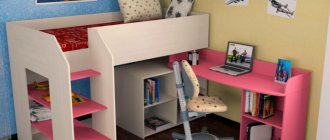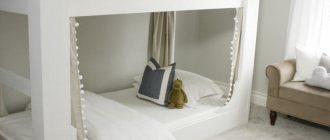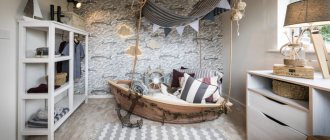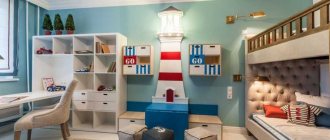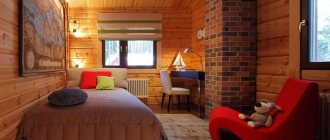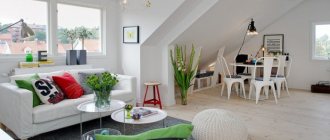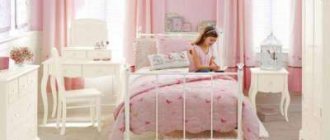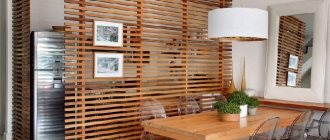Sooner or later, every parent faces the problem of allocating space in the nursery. Proper zoning is the key to the safety and functionality of the premises. Long gone are the days when a child’s bedroom was associated only with a place to relax. In the modern world the rules are completely different. A children's room is a personal territory where a child invites friends, learns and develops. Therefore, it is very important to create an atmosphere of comfort and ease. Dividing space into zones can help with this.
The children's room is a multifunctional room.
The need for zoning in a children's room
The cozy atmosphere of any room consists of well-placed priorities. The children's room is no exception. Dividing space into sectors is a very relevant topic for moms and dads. Loving parents with special trepidation arrange a separate room for their children, combining 4 zones in one place at the same time: for sleeping, playing, leisure and storing things. This technique has clear advantages:
- The ability to make several rooms out of one without reducing the total area.
- Space optimization.
- Teaching a child to order in an unobtrusive manner.
- A budget-friendly way to change the interior without erecting solid walls.
- Visual increase in space due to glass cabinets and open partitions.
In order for children to develop responsibility and maintain routine and order, zones are needed in the children's room.
The main goal of zoning a nursery is to create conventional boundaries for a more comfortable stay. It is easier for a child to concentrate on a certain type of activity if the room design is divided into zones. It is clear that everything will not remain strictly in place. But the baby will realize that every thing has its own place.
For very small children, it is worth preferring to zoning the space with interior items; it is easier for school-age children to navigate by color and decoration, especially since the dominance of furniture can lead to injuries.
Competent arrangement
The design of the nursery is developed based on the characteristics of the room and the needs of the child. The boy will be satisfied with laconic, even somewhat rough methods of dividing the room. Girls appreciate an elegant interior, when every partition or zoning furniture pleases the eye.
- Soundproofing children's rooms. It is better for children to allocate a room away from the kitchen or living room, especially in families that often receive guests. For additional sound insulation, plasterboard or wooden shelving systems are often placed around the entrance to compactly accommodate a bunch of children's little things (from toys to clothes). If there are musical instruments in the nursery, it is worth creating a powerful soundproofing system - it will “eat up” the free space, but will save the neighbors from dissatisfaction.
- Daylighting. Ideas for zoning depend on the degree of illumination. It is better to provide children with a western or eastern room so that during the daytime the entire room receives enough light.
If the children's windows overlook a quiet courtyard, you can place a bed under the window - in this case, you need to install high-quality metal-plastic windows. Girls often have a natural tendency to sit by the window, so they will be delighted with this arrangement. The boy will be more interested in the sports corner and the play area of the room.
Option for dividing space for children of different ages
Designating a seating area with a multi-level ceiling
Types of zoning
Zoning a children's room can be done in several ways: using individual parts or in combination with each other. The second option is preferable, because Each sector should have not only a certain semantic load, but also a characteristic stylistic orientation.
Zoning of a children's room is done into three zones: where the child sleeps, where he plays and where he does homework.
Demarcation using furniture
The most popular method among parents. The children's room can be divided into 4 sectors.
- For sleep
The purchase of a sleeping place depends on the total area of the space. For small rooms, sets combined with cabinets are suitable. It is not uncommon to find bunk beds with an additional set of storage spaces. These can be drawers, hanging systems. If there is enough space, then it would be nice to complement the set with a bedside table with a table lamp. You should not place the bed near the window opening. The best place for her is along one of the side walls.
The less lit part of the room is perfect for placing a child’s sleeping place.
- For games
We can say that this is the center of the children's room. There should not be any massive pieces of furniture in this place. Depending on the age, there may be a children's table and chair, soft poufs, bean bags, an easel for drawing, etc. something that can be easily moved.
When defining a play area in a child's room, do not forget that most children's active play takes place on the floor.
- For study
The content takes into account the age and hobbies of the child. The main attention is paid to the illumination of the area. The desk should be functional with plenty of drawers and shelves. It is recommended to place it opposite the window so that natural light falls on the left side for right-handers, and on the left for left-handers. Take care of additional shelves for books and other devices for the educational process and creativity. You can opt for a high rack, which can also take on the function of delimiting space. Pay attention to the so-called “growing desks”. These sets can be easily transformed as the child grows.
If your child is studying at school, then you definitely need to purchase a table and chair and place them by the window.
- For storing things and toys
Storage furniture should be spacious and safe. This includes cabinets, chests of drawers, and shelving. The main thing is not to overdo it, but to buy only the most necessary and functional things. It is preferable to make furniture to order, although stores offer a good range of these products. Here the emphasis is on ensuring that the child gets the thing he needs without difficulty or danger to his health. Ideal options are a corner wardrobe, a regular rectangular wardrobe with pantographs and drawers. Separately, you can provide additional storage space in a bed, sofa, pouf.
This division will help indicate to the child where and what to do in his room.
Zoning using finishing
A variety of devices and devices are used: multi-level ceilings, podiums on the floor, construction and finishing materials of various colors and textures. An excellent solution is a plasterboard partition. It can be openwork and light, and serve as additional storage space. Or, conversely, massive throughout the entire height of the room, serving as a wall.
An excellent solution for areas in a children's room can be the use of visual barriers.
As for the color scheme, it is advisable to give preference to calm neutral tones for the bedside area. Brighter accents are suitable for diluting the contrast in the gaming sector. You can also use rich photo wallpapers to stimulate the child’s activity, and as they grow older, replace them with regular ones.
The visual division of a children's room can be constructed using various furniture, curtains or stationary partitions.
Zoning with decorative elements
Floor decorations, flower arrangements, floor aquariums, vases, thought pillows, lamps, etc. are a great way to divide a room, but not a child’s room. Closer to adolescence, these interior items are appropriate to use, because... the child becomes calmer. Begins to think more consciously. Until this time, if you really want to use a decorative element as a way of zoning, it is better to opt for a carpet. It should be oval or round, brightly colored, without long pile. And the additional ornament will make it stand out from the rest of the room elements.
Carpeting can be used as a play area.
Furniture
The quality of the chosen furniture directly affects the health of children. It should be reliable and strong, made of hypoallergenic materials and preferably lightweight so that the baby can move it independently. No sharp or protruding parts! We also remember about protecting sockets and insulating wires.
A properly equipped nursery will help to quickly develop independence. Place switches and shelves at such a height that the child can reach them himself. At five years old it is approximately 130 cm, at 7 years old – 150 cm.
Options for zoning a nursery depending on the gender of the child
The gender of the owner of the room plays a key role in determining the design of the room and its division into zones. For newborns, zoning is not particularly important, but by the age of 3-4, when children begin to actively explore the world around them, it’s time to think about it.
The main task of zoning is to create separate sections of the room, inside which unnecessary things will not distract his attention.
Zoning for a boy
It is known that boys are much more active and restless than girls. This factor should definitely be taken into account when developing an original interior design. The presence of boyish paraphernalia determines the future interior.
The most important factor when choosing a zoning method is always the age of the child.
For fidgets, it is appropriate to allocate maximum space for games and sports activities. A bookcase is more suitable for calm children. Among the available materials for zoning are:
- Multi-colored wallpaper on the walls will help you calm down during sleep and activate motor activity during games.
- Mats, thick, durable carpeting in the play area
- Furniture without sharp corners
- All kinds of drawers and shelves for storage.
You must understand that you need to use the option that will be most naturally perceived by the child.
Zoning for girls
The principle of space distribution is different than that of the opposite sex. It has been scientifically proven that young ladies are prone to role-playing games, and little gentlemen are prone to active activities. Therefore, the more various decorative elements there are in the room, the more interesting the interior becomes. You can successfully divide a room using:
- Curtain
- Drapery
- Light artificial partitions with shelves and drawers
- Dressing table or dressing table
- A doll's house.
It is worth noting that different ceiling levels do not have the same effect as a multi-level floor, and this must be taken into account.
Correctly set design priorities will ultimately create a true masterpiece of art. A beautiful room is pleasant not only from an aesthetic point of view. Its decoration is designed to instill in the baby a sense of beauty and the desire for perfection.
Zoning for children of different sexes
How to divide a children's room into two zones is a question that worries parents who have more than 2 children. Space restrictions may include:
- Different color schemes for walls and furniture
- Partitions, screens.
Children respond well to zoning a room into a bedroom and a nursery using decorative items, color schemes and the like.
This will give children personal space. The ideal option is for everyone to have their own bed, wardrobe and table with chair. But if the quadrature does not allow this to be done, then you can create something like a living room. Place two small sofas side by side and a furniture cabinet opposite. The table can be made folding or you can choose a folding table. Hanging shelves and drawers will help save precious meters.
Difficulties may arise when organizing areas for children of different sexes. In this case, sleeping places should not be located nearby. The contrast of the palette of shades will allow you to create the illusion of 2 rooms. The task can be accomplished by arranging headsets not according to functional characteristics, but according to gender, when the zones of girls and boys do not overlap.
It always works best with children to have clear physical divisions into separate areas that will create boundaries.
There is no clear answer on how to correctly divide a children's room into 2 zones. You should be guided by the hobbies of your daughter and son, the design of the external appearance of the room and personal experience.
For school-age children: setting up a workspace
School is a new stage for children, which involves preparing the room. For studying and studying, you will have to allocate a work area, and ideally two. There is a need to increase storage space for books, notebooks, school or sports uniforms.
How to create a separate workspace?
It is advisable to provide each child with his own table. This will help avoid confusion in things and possible conflicts.
Depending on age, the set of accessories will be different. For example, a high school student may need a computer for studying and a corresponding desk for it. Preschool children will need smaller furniture to feel comfortable.
In a minimalist style
If you place children's workplaces at a remote distance, schoolchildren will be able to concentrate on work more easily and will be less distracted by each other.
The play area in the schoolchildren’s room can be given less attention or eliminated altogether. You can draw, sculpt or do other hobbies at your desk, and the extra space will make the room feel freer and suitable for active games.
Bedroom and dressing room
We try to locate the sleeping area away from windows and doors so that children can get some sleep before classes, and the morning sun or noise will not disturb their sleep.
The beds can be placed side by side, separating them with a screen or chest of drawers. If the age difference between children of different sexes is significant, if possible we plan sleeping places at a distance.
Stylish room, in bright colors
It is best to combine the dressing area by allocating a large closet for children. But we make cabinets or shelves for school supplies individually for each person. These can be pull-out shelves in the table, narrow single-section cabinets, wall shelves or racks.
Is it possible to accommodate three children?
Placing three children in one room is not an easy task, especially with limited space.
You can arrange a nursery for three taking into account the following recommendations:
- We try to free up as much space as possible. Compact furniture that can accommodate a lot of things without taking up much space will help out.
- We separate his area for the child. This is necessary for normal development, rest, games, and activities.
- We don’t force the room - let each thing have its purpose. An overabundance of furniture, toys and unnecessary things will make the room look like a storage room.
Classic style
Zoning a nursery for three
To avoid conflict, it is very important to distribute the space equally. This way the children will get along peacefully without envying each other.
Let's consider the zoning methods that can be used as a guide:
- We provide each child with an individual space in which he will be comfortable. At the same time, the separated area must satisfy all the needs of the son or daughter.
- We plan the interior so that the room is divided into a sleeping, play, work, and dressing area.
When dividing a bedroom, consider the following recommendations:
Place the sleeping area away from window and door openings
- We place the sleeping area away from window and door openings. Bright light or noise will interfere with your rest.
- We try to provide the play area with everything necessary: for outdoor games you will need additional space, a wall bars, and for hobby activities, a table and additional lockers.
- It is enough to provide a work or study area with tables, chairs, hanging shelves for storing books, notebooks and additional lighting.
- We arrange the dressing area as ergonomically as possible.
Dividing the bedroom into zones is a beneficial solution if space is limited. It is better to divide a large room into individual zones for each child.
Provide each child with their own space
How to combine and match different zones?
In most cases, some zones can be combined. This allows you to rationally use space and not overload the interior.
The sleeping area can be combined with a dressing room. To do this, we use ergonomic options:
- loft bed;
- a bunk bed with a wardrobe supporting the second tier;
- three-tier bed, with built-in supporting cabinets for the tiers. As a rule, the third berth in such beds is usually located perpendicularly.
- bed with drawers for storage.
The play area can be combined with a relaxation space. Also consider eliminating an area. If all children are school age, there is no need for a large play area. Preschool children will not need a work area to study.
Separation using color
Baby cots from 1 year to 3 years for boys and girls: TOP 7 types + 215 PHOTOS
Choosing a style for the nursery
Without choosing a style, the children's interior will look unfinished. You can, of course, experiment and mix directions. But such a decision will not have the best effect on the decoration of the room. A feeling of discomfort will prevail during your stay in it. It is more appropriate to settle on one style, decorate the walls, ceiling, floor, choose furniture and decorative elements according to its canons.
Children's room for a girl in pop art style.
Modern styles with a predominance of simple, uncomplicated shapes, smooth lines and transitions, a minimum of accessories for decoration, and smooth, even surfaces that do not require special care are extremely popular. And furniture elements can be easily replaced with similar ones if they break down or added as needed, without worrying about the harmony in the atmosphere.
Children's room in a modern style.
However, the same cannot be said about classical styles. A room made from this perspective looks expensive and pompous due to complex additional elements: ruffles on curtains, furniture columns, carvings, twisted legs, stained glass windows, mosaic details, etc. In classic interiors there are many fragile, glass and easily soiled elements that are difficult to change or wash. If you choose classics, then you should give preference to modernity and classicism, where luxury is not used in the design, but is based on simplicity, rigor and rationality.
Children's room in a classic style for a girl.
Among modern styles, the following stand out:
- Minimalism
- Scandinavian style
- Loft
- High tech.
Rooms designed in these directions look harmonious, neutral and restrained, suitable for any age and any size, which cannot be said about the classics.
A Scandinavian-style children's room is suitable for both boys and girls.
The art deco style stands apart, where the rule about the inadmissibility of a mix of modern fashion trends and the good old classics is violated. A characteristic feature is the combination of bold colors and shapes with deliberate chic and luxury.
Options for decorating a children's room
You can create a cozy space not only with well-arranged furniture, beautiful wallpaper and flooring. The highlight is small accessories that add comfort, create a calm, friendly environment, and make the interior complete. From childhood, a child should be surrounded by beautiful things so that in the future he develops a sense of beauty.
Along with the physical separation, you can use different decorative items, which over time will help make the necessary associations.
The most popular ways to decorate and delimit space include:
- Purchased and homemade garlands.
- Suspended structures - mobiles.
- Inserts from children's photographs and drawings.
- Vinyl stickers.
- "Outfits" for furniture.
- Shelves for the most necessary things.
- Themed decorations for holidays and important dates.
Photos of interesting ideas for zoning a nursery
Photos of interesting ideas for zoning a nursery are presented below.
Plasterboard structures require proper design.
When planning a space for a nursery, it is important to remember that there should be no general imbalance in the room; all elements are designed to complement each other. By adhering to this rule, you will be able to create a harmonious look without a feeling of clutter and unnecessary things. Remember, a children's room is a reflection of the character and characteristics of a little person.

